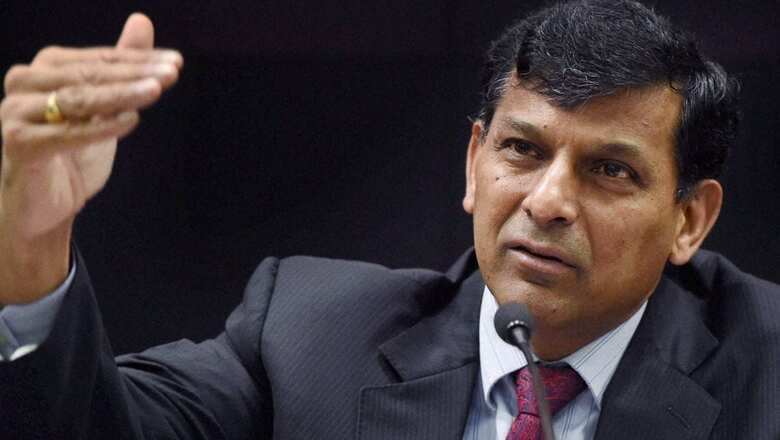
views
It was one morning in December 2022. The two men sat side by side, under the winter sun. India will be “lucky to get 5 per cent growth” next year, Raghuram Rajan told Rahul Gandhi. The next day it was all over the newspapers. Coming from Rajan, it was already as good as true. But this was not the first time that the media had taken either of these two individuals more seriously than it should have. ‘If Rajan exits, so will billions in investment’ ran one headline in 2016. That was when his term as governor of the Reserve Bank was about to end. Rajan also made headlines in June 2015 when he predicted that a 1930s-style Great Depression was coming. What happened to that?
From 2013 to 2018, Rajan “predicted” doom for the global economy at the rough rate of once a year. Each time, the media covered him. The media never learns. But this time, something new happened. Something that rarely happens to star economists. People followed up. They made clippings of his “lucky to get 5 per cent” speech and began posting it online. Every time India posted its high growth numbers, the videos went viral. A dazzling 7.8 per cent in the first quarter of the 2023-24 fiscal year, and 7.6 per cent for the second.
The world is cheering on India. And people online are laughing at Raghuram Rajan.
And so, it is for the first time ever, that a cornered Rajan has been forced to defend himself. In recent interviews, he said that all these people are trolls. He says it is an organised effort against him. But it is not. It is just common people speaking truth to an economist they now see as more political than academic. For that matter, Rahul Gandhi’s Bharat Jodo Yatra, during which Rajan originally made these comments, was also an organised effort. The question is whether the critics are wrong, not whether they are organised.
So here are five ways in which we believe that Raghuram Rajan is wrong about India’s economic path.
India is not growing faster simply because we are a poor country
That was the first defence from Rajan, in an interview he gave to The Wire. “We are growing faster than other large economies…Poor countries grow faster because catch-up growth is easier. There is so much more to do, and we know what to do,” he said.
First of all, when Rajan made his prediction in December last year, did he not know that India is a poor country?
Second, note the obvious flaw in the argument. If India is poor now, it was even poorer during the UPA years. Why then was India the slowest growing BRIC economy between 2004 and 2014? Between 2004 and 2014, China expanded its GDP by an astonishing 430 per cent, Brazil by 266 per cent, and Russia by 222 per cent. In contrast, India could only manage 181 per cent. In fact, Indonesia increased its GDP by 219 per cent. No wonder that by the end of UPA’s term, there were calls for Indonesia to replace India as the “I” in BRIC!
Here is another way to look at this. When the UPA decade began in 2004, India’s GDP was about 37 per cent that of China. By 2014, it had been reduced to just 19 per cent. In other words, India’s economic size relative to China had been cut in half. The lesson is that poor countries do not magically grow faster. You need a good policy.
India has grown due to its own strength, not just because of global factors
“We have been lucky,” Rajan explained in another interview. He added that after he made his “lucky to get 5 per cent growth” comment, it was not just India but the whole world that grew faster than he expected. But India’s growth was ahead of the rest of the world. Since 2014, India’s GDP has increased by 83 per cent. This is well ahead of China at 68 per cent, and the United States at 53 per cent. Most European countries have been under 10 per cent. India’s peers in BRIC, such as Brazil and Russia have actually seen their GDP contract significantly by 10-14 per cent. As for Indonesia, it grew 59 per cent, well behind India’s 83 per cent. There is no longer any danger of Indonesia replacing India in BRIC.
So India went from being the slowest growing BRIC economy in the UPA years to the fastest growing since 2014. Why deny credit to India and the current Indian government? But let us come back to the comment that Rajan made about “luck.” Not just India, but the whole world grew faster than he predicted. So he was wrong not just about India, but the entire world economy. How is that supposed to be an excuse? And why does he blame his failure on “luck?”
Remember that Rajan is most famous for having “predicted” the 2008 crisis back in 2005. Was that success due to “luck” as well? Worse, we should go beyond the media myths and ask if Rajan actually predicted that 2008 crisis. You see, predictions are supposed to contain specifics. Like when Rajan said that in the 2023-24 fiscal, India’s growth would be under 5 per cent. So there was a date and a number against which the success or failure of his prediction could be measured. But his words in 2005 contained no specifics. He merely said that something might go wrong at some point in the future.
But that was always going to happen. Every decade has at least one big economic crisis. There is always going to be another plane crash, or another earthquake, flood or drought someday. This is not a prediction. This is called stating the obvious. Since then, Rajan has predicted many more recessions, including in 2015 when he predicted a 1930s-style Great Depression. None of these came true. Perhaps his luck ran out.
India has the potential to become a manufacturing superpower
Do iPhones that are made in India smell of curry? The allegations are all over Chinese social media. Yes, the Chinese Communist Party (CCP) is beginning to panic, now that more and more Apple merchandise is being made in India. Or shall we say “assembled” in India? After all, we would not like to hurt the feelings of domestic critics who seem no less nervous than the Chinese.
What an amazing lack of vision these critics have shown! In the second quarter of 2022, Apple accounted for just 9 per cent of smartphone exports from India. In the same quarter of 2023, it is more like 49 per cent. This fiscal year, Apple is set to overshoot its export targets under the PLI scheme by a huge margin. Over the next five years, they are likely to raise production from $7 billion worth to over $40 billion. India is beginning to put together the basics for a manufacturing revolution. The expressways, the railway freight corridors, the seaports and waterways are being put together.
How can someone bet India’s future, as Rajan suggests, purely on services? Especially with so much of the global supply chain in the hands of China. Did we learn nothing from the pandemic? For example, Apple’s supplier Foxconn is the 10th largest employer worldwide, just behind the Indian Railways. Who would not want them here? And yes, we also need to get into the new race for semiconductor chip manufacturing. This is an economic necessity and even a national security issue.
But over the last year or so, Rajan has made a name for himself as a savage critic of India’s manufacturing prospects. Clearly, he does not understand that India has a history of starting from humble origins and making it big. From steel to cars to satellites. Back in the day, British officer Upcott had joked that he would eat every pound of steel if Indians could make any. Today, India is the second-largest producer of steel in the world.
India has managed to balance both stimulus and inflation fears perfectly
The patient is on a sickbed and needs a tonic immediately. So said Raghuram Rajan in his 2020 blog, as he made his case for a huge fiscal stimulus during the pandemic. One that India possibly could not afford. And one which would likely lead to runaway inflation. The support from the government, primarily in the form of foodgrains, was “meagre,” he had said. But look at what happened next. India bounced back sharply and posted world-beating growth numbers in 2021, 2022 and now 2023. All this while inflation stayed around 5-6 per cent and the Rupee was stable. Now the International Monetary Fund (IMF) expects India to remain the fastest-growing economy at least until 2028.
And look at what happened in the West. They handed out massive stimulus packages. But it all backfired, producing low growth and high inflation. They got a small bounce in growth figures for 2021. But it quickly went downhill after that. Most Western economies slipped back to 2-3 per cent growth, while inflation soared to 9-11 per cent. The US itself saw two successive quarters of negative growth in 2022. This used to be the technical definition of a recession, before “economists” changed it in 2022 to suit midterm election prospects for President Biden’s party.
On his part, Raghuram Rajan has done an about-turn as well. He now blames central banks in the West for not being careful while giving out big stimulus packages. Anyone who remembers what Rajan himself said in 2020 must be a “troll.”
India does not need authoritarians; democracy has served India much better
Perhaps the most puzzling comment comes from Rajan’s recent book with Rohit Lambda. “India may have democratized too early. Perhaps strong manufacturing growth in its early years required an authoritarian hand to remove the obstacles in the way of development,” they write. Rajan doubled down on these comments in his interview with Karan Thapar. He pointed, as people often do, to the authoritarian leaders who created economic miracles in East Asia. But Rajan ignores the facts about Indian history. Can authoritarian leaders sometimes serve the economic interests of a nation better? Yes, it is true, even if it is an uncomfortable truth. But it really depends on which authoritarian. An authoritarian leader like Lee Kuan Yew of Singapore? Yes. But an authoritarian leader like Indira Gandhi? No. Having an authoritarian leader is not a guarantee of economic prosperity.
In fact, how different was India from an authoritarian state between 1950 and 1991? There was practically a Congress monopoly. Leadership in the party was passed down by the principle of hereditary succession. Non-Congress governments could technically be elected in states. But these were often dismissed in bulk. During this time, India went from the sixth-largest economy in 1950 to the twelfth-largest in 1991. In 1950, India’s per capita GDP was 18 per cent of the world average. By 1991, it had come down to 6 per cent. So the average Indian became roughly three times poorer between 1950 and 1991. So much for the advantages of authoritarianism. The Congress monopoly was shattered in 1991. Since then, India has become a lot more democratic. And India has done better in every way.
One final note from history that everyone deserves to know. One that Raghuram Rajan should keep in mind before he begins this dangerous talk about authoritarianism in India. In the 1950s and 60s, the US government brought over a group of economists from Chile and trained them at the University of Chicago. These people came to be known as the ‘Chicago Boys’. The Chicago Boys formed the core of Pinochet’s brutal dictatorship after the CIA-led coup overthrew the elected government of Chile and installed a puppet regime in 1973. As a Chicago economist himself, Rajan would surely be aware of this story. And we would advise him to choose his words more carefully when talking about authoritarianism.
Abhishek Banerjee (@AbhishBanerj on “X”) is an author and columnist; Karuna Gopal (@KarunaGopal1 on “X”) is president, Foundation for Futuristic Cities. Views expressed in the above piece are personal and solely that of the author. They do not necessarily reflect News18’s views.


















Comments
0 comment